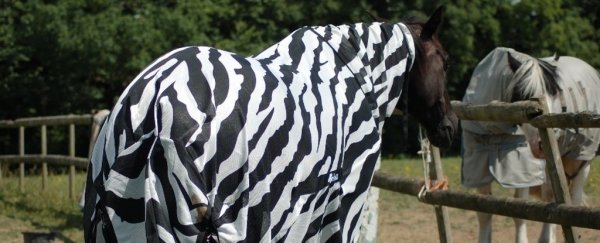We know that many of the traits we see in animals are there because they evolved by somehow being useful to the species. But evolution is messy, and the supposed benefits of weird features aren't always obvious. Take zebra stripes, for example.
The stark black and white garb of the three zebra species roaming Africa has been a biological puzzle for decades, with several competing hypotheses. Now researchers have added a new data point - and all it took was playing dress-ups with some horses.
Okay, there was more science than that. But the team's results showed that the stripes somehow prevent flies from landing - keeping zebras relatively safe from the annoying insect bites.
It's not a new idea. Scientists have known for years that fewer flies land on zebras. A 2012 study even found that the light and dark stripes together could reflect polarised light in a way that deters flying insects.
We're still not entirely sure of the exact mechanism, but scientists from the US and the UK have narrowed it down. They have found that flies land on horses over three times as often as they land on zebras, because the stripes apparently confuse the insects and diminish their ability to control their flight.
The team spent several hours observing both horses and zebras to record the number of blood-sucking horse flies (tabanids) buzzing around, approaching, and landing on the animals.
Then, to make sure there wasn't something inherent about zebra scent or movement that changes fly behaviour, they turned to disguises as an attempt to rule out those variables (zebrables, if you will).
To do this, the team dressed horses in coats - solid black, solid white, and black-and-white striped - and recorded fly activity again. They also took videos of both horses and zebras to perform a detailed analysis of what the flies actually do; and to watch the behaviours of both types of animal in response to flies.
They found that flies hang around both animals in roughly equal numbers, and approach zebras just as often as they do horses. But when flying towards a striped coat? That's when things go a bit haywire.
"We noticed that tabanids approaching zebras failed to decelerate in a controlled fashion towards the end of their flight trajectories whereas they steadily decelerated before landing or touching horse pelage," the researchers wrote in their paper.
"Flies often simply bumped into zebras but fail to land or fly away."
Interestingly, the flies still landed on the exposed head of the horse wearing the striped coat as often as they did on normal horses - indicating that the coat was having an effect.
And that's not all. When the flies did succeed in landing, they didn't stay as long on zebras. The videos recording the animals' response to flies showed that zebras flick their tails and run away from flies more actively than horses.
Overall, the reduced time spent on zebras meant that the flies didn't bite or feed on them as much as they did on horses, showing that the stripes do indeed play a role here.
Of course, it's possible that the stripes perform multiple functions. So far studies appear to have ruled out environmental camouflage, social interaction and thermoregulation, but there's still a possibility that the stripes confuse predators by producing a sort of 'dazzle' effect as a sort of motion camouflage that makes it hard to distinguish individuals in a closely packed herd.
But the evidence here does indicate that one of the benefits conferred by stripes is increased protection against biting flies.
We wonder if that's the last we'll hear about it.
The team's research has been published in the journal PLOS One.
